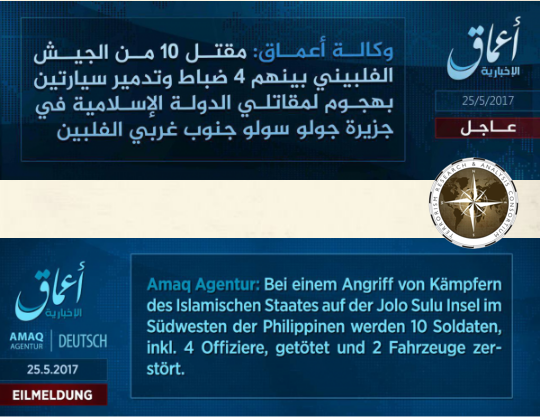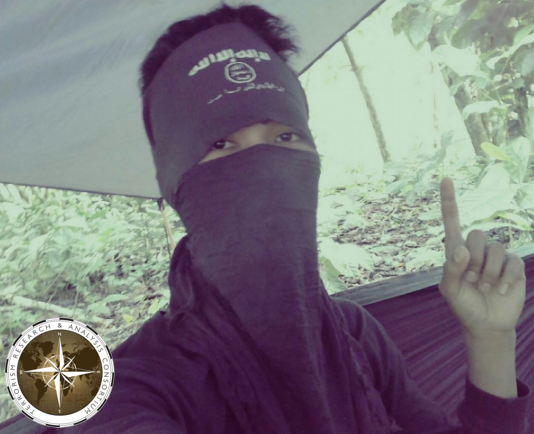Why is this significant?

Claims for the 25 May 2017 Sulu attack. Image courtesy TRAC
At 5:30 am on May 25, 2017 in the Pakitul area of Sulu, Abu Sayyaf Group (ASG) militants opened fire on the Philippine troops sent to search for them. A military spokesman reported 11 soldiers wounded, with one dying from his injuries. That day the Islamic State (ISIS) caliphate-run Amaq News Agency released a statement on Telegram claiming ISIS fighters killed 10 soldiers on Sulu, including 4 officers.
This was the first attack on Sulu ever claimed Islamic State. First, by the quasi-official Islamic State media outlet “Amaq" and the official ISIS statement confirmed the Amaq claim later in their Rumiyah (“Rome”) magazine, both distributed on Telegram channels.
Why is this significant?
ASG factions
It is the conventional wisdom among analysts that the Abu Sayyaf Group, since 2014’s ISIS caliphate declaration, had splintered into a pro-ISIS faction – the Basilan contingent led by Isnilon Hapilon – and a Sulu-based, locally-focused faction, tethered to ASG cofounder and figurehead Radullon Sahiron. Back in September 2016, an attack in Basilan was claimed by ISIS and reprinted in Rumiyah’s premiere issue. It wouldn’t be until the magazine’s 10th issue that Sulu received the same recognition.
ISIS-designated emir Isnilon Hapilon, in a photo in Rumiyah magazine's 10th issue. Photo courtesy TRAC
As Victor Taylor of Canada’s Mackenzie Institute has written for MindaNews, ASG Sulu is made up of loosely linked groups nominally under the gaze of Sahiron, who has not welcomed foreign fighters. Taylor notes what TRAC and other ASG watchers have concluded: that Sulu groups sometimes mimic the stereotypical ISIS imagery for their videos and use ISIS flags, but this, “is more a part of the negotiating tactics adopted when demanding ransom payments, rather than an indication of affiliation with ISIS.”
Sulu ASG, a triple threat
If any faction (or group of subfactions) is more infamous, successful and dangerous, it is the non-ISIS-linked Sulu bandits.
ASG Sulu groups do not need ISIS backing due to their booming kidnapping-for-ransom trade and local support. They have earned their fearsome reputation by beheading foreign nationals and seajacking the vessels of various countries (they still hold nearly two dozen hostages). And they can fight on land as well: In April, an attempt by Philippine Army to rescue Vietnamese hostages on Sulu ended with “32 wounded soldiers” according to officials, which likely means at least several died.
All that said, since the Basilan ASG under ISIS-designated emir Isnilon Hapilon joined with the Maute Group began the Marawi City siege, their Islamic State East Asia/Philippines franchise (ISEA) has overshadowed Sulu on the international stage. Rumiyah magazine issue 10 was dedicated to ISEA, including an interview with Hapilon.
Another ISIS Sulu claim
The July 8, 2017 claim for the Sulu attack. Image courtesy TRAC
As Isnilon Hapilon and ISEA have gained global attention and cemented the Islamic State brand in the Philippines, the emir’s influence might have brokered the consolidation of the Abu Sayyaf Group under the Islamic State banner, merging at least some local armed groups with the international movement. In his Rumiyah interview, Hapilon stated the biggest problem for the Muslims of the Mindanao archipelago was their factionalism and lack of unity.
ASG Sulu losing leaders
Aside from the Marawi siege, which Hapilon orchestrated, there is another reason the timing is right for an ASG Sulu shift toward the Islamic State: Aging ASG cofounder Radullon Sahiron has opened talks with the Philippine government to turn himself in.
Sahiron long distrusted foreign fighters and did not need foreign funds due to a lucrative KFR trade. Still on the run, he is pressured by a Philippine Army campaign on Sulu, Basilan and Tawi-Tawi islands since January following President Duterte’s promise to wipe out ASG in 6 months.
Sahiron reportedly would make a deal with Manila on the condition that he not be turned over to the United States, which has a $1 million bounty on his head.
Muammar Askali connection
Muammar Askali aka Abu Rami. Image courtesy TRAC
Reportedly close to Hapilon and trained by the infamous Malaysian bomb-maker Marwan (Zulkifli bin Hir), Askali pledged allegiance to ISIS but still remained close to Sahiron. Notorious for the kidnapping and beheading of foreign nationals, including a German sailor in February 2017, he was another important link between local families on Sulu (where his uncle was a Moro National Liberation Front leader) and the Pacific Rim jihadists from Malaysia and Indonesia converging in the region. There are reports he was being groomed to replace Sahiron as Sulu chief.
After the Bohol attack became a media spectacle for its representative threat to northern Philippine tourist spots, the government stepped up the military campaign on Sulu. Another Askali associate and bomb-maker, Alhabsy Misaya, was shot down in Sulu. ASG militants on Basilan and Tawi-Tawi islands are reported to be surrendering in droves due to Army pressure.
Force multiplier
There are doubtless many connections among ambitious jihadis on Sulu with those from Mindanao to Malaysia; yet these new claims speak to stronger, more formal ties among groups.
The merging of ASG Sulu crews with the official media houses of the “Khilafah” (not to mention the legions of ISIS fans on social media) could act as a force multiplier for both in international propaganda, recruitment and resources. It is a significant win for those such as Hapilon and the Mautes who have been trying to unite all South Philippines Muslim insurgents under the ISIS banner and create a beacon of jihad in the region.
ASG Sulu could use more foreign fighters to swell its ranks and more sanctuaries to escape to. As Islamic State East Asia struggles to establish itself, any increase in cooperation from Sulu or coordinated attacks across the Mindanao archipelago would further sap the strength of the Armed Forces of the Philippines and embarrass Manila.
[Michael Quinones is a Research Associate who specializes in jihadist activity in the Pacific Rim, Middle East and Turkey for TRAC: Terrorism Research & Analysis Consortium. TRAC is a digital intelligence repository on political violence and terrorism and can be accessed at http://www.tracterrorism.org/. Follow us on Twitter at @TRACterrorism]
http://www.rappler.com/nation/175812-trac-abu-sayyaf-isis-alignment




No comments:
Post a Comment
Note: Only a member of this blog may post a comment.